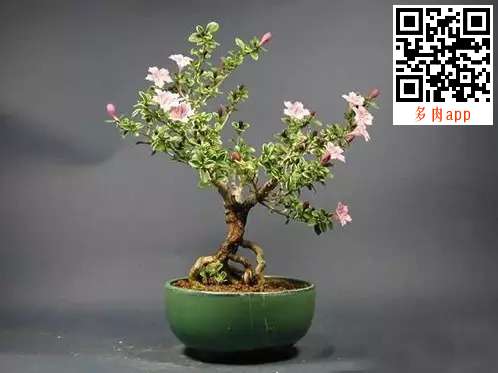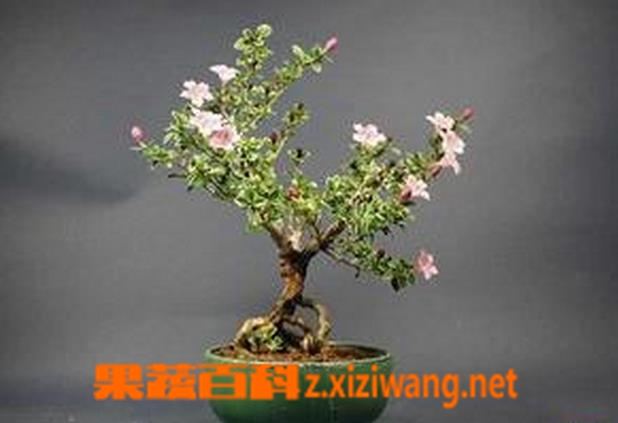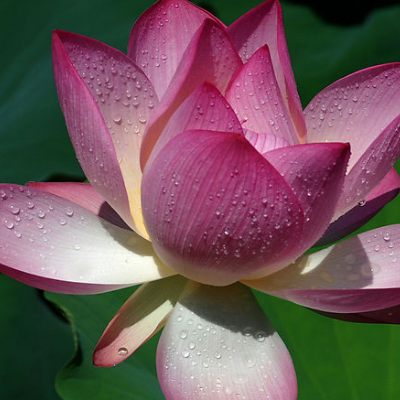Production and maintenance of snow bonsai in June
1. Production of snow bonsai in June
In June, snow leaves are small, flowers are small, stems are curved, roots are developed, roots are tangled, branches are many, and germination is strong, which can be made into bonsai such as single-dry type or Shuanyu type, multi-dry type, stone-attached type, cliff type and so on.
(1) material selection. From March to April in spring, the stump with strong stem, many branches, developed root system and certain shape was selected, dug out from the ground or removed from the culture basin, and conceived and modeled according to the tree shape. The single stem is tied into qu Gan, the cliff type, the double stem into the dependent type, and more than the jungle type. According to the thickness of the trunk, determine the height of the trunk, thinning the excess branches and trunks.
(2) put on the basin. Take the selected June snow tree stump, remove the root soil, make the root bare, and trim the root properly. The roots of the small stumps are pulled up by hand and planted in the human basin, covered with culture soil to reveal the roots. If the stump is slightly larger and the root is thicker, the plastic belt can be used to tie up the root, form the root and claw root, cover the soil on the basin, and expose part of the root. If the stone is attached, press the root strip into the stone seam, the stone ditch or wear the cave, stick the root to the stone body, bind it firmly with plastic tape, and cover the soil on the basin. The basin soil covered with stone-attached stones in 1, 2, 1, 1, 3, exposing part of the root. The new June snow should be kept in a cool and humid place for a period of time. When the new branches of the pruned stump grow 3 to 5 cm long, the basin should be moved to a semi-shady place for normal management.

June snow bonsai maintenance skills: June snow bonsai production is more time-consuming, so maintenance can not be careless, otherwise it will affect the beautiful effect of bonsai, only understand the growth habits of June snow, can better maintain it. June snow like the sun, but also more resistant to shade, avoid strong winds and hot sun, high temperature and hot season should be shaded. Snow planting in June should be planted in the spring, or cut during the yellow plum rain, and shallow tea should be watered. It is not strict on temperature. It is evergreen in South China and semi-evergreen in Southwest China. The drought tolerance is strong, and the soil is not strict. Snow pot cultivation in June should use slightly acidic and moist soil containing humus, loose and fertile, strong permeability to make it grow well. Snow bonsai cultivation in June must choose soft mountain soil, should be placed in the sun, can not be kept indoors for a long time. Fertilizer should be applied twice during the growing period, and the basin soil should be dry. Too much fertilizer and too much water will lead to excessive growth of branches and leaves. In addition, in order to ensure that the snow bonsai plants in June are symmetrical and plump, they also need to be trimmed and reshaped for artistic processing. The snow bonsai in June should be in a fixed position and should not be moved from east to west. June snow pays attention to light. In summer, it is necessary to shade the sun in the hot sun, keep ventilated, spray water to its leaves once or twice a day, and maintain air humidity. In cold winter, straw can be slightly bandaged (about-10 ℃) to avoid freezing to death. Production / maintenance management of snow bonsai in June
Production of snow bonsai in June
Snow in June, white flowers bloom in summer, and the flowers are as dense as snow, so it gets its name. June snow is an evergreen shrub, suitable for miniature bonsai, can be placed in the house to decorate the environment. It is elegant to put a pot of June snow bonsai on the table with clean windows.
Selection and cultivation measures of Snow Bonsai in June
1. Artificial propagation: it is usually propagated by cutting or tillering. Hardwood or softwood cuttings can be used, hardwood cuttings are carried out from February to March, with dormant wood as cuttings, tender wood cuttings are carried out in June-July plum rain season, and semi-mature branches are used as cuttings. Nursery bed soil should be deep, fertile and moist, ear length 6-8 cm, insert depth 12, need tower shed to cover B shade after insertion, pay attention to watering, keep soil moist, easy to survive, and can be transplanted in the following spring. Tillering propagation is carried out in March in spring. The plants with sprouting roots are dug up from the roots, split with a sharp knife and planted separately with roots, which is easy to survive.
2. Mountain mining: there are many wild snow mountains in June. Old piles with strong roots can be selected and cultivated in the shady, wet and fertile soil. When the root system resumes growth and the branches and leaves are luxuriant, they can be transplanted into the basin.
The process of potting snow bonsai in June
1, selection basin: June snow more shallow rectangular or oval basin, the texture can be used purple sand pottery basin or glazed pottery basin, the color should be deeper.
2. Use soil: June snow should use slightly acidic loam which is rich in humus and has good drainage. Potted plants can use rotten leaf soil or sun-dried frozen loose pond soil, the bottom of the basin covered with a layer of river sand and leaves to facilitate water penetration.
3. Planting: it can be planted in pot in early spring or late autumn, and part of the long root can be cut off when planting. If it is a wild old root pile, the root can be lifted properly to show the old posture.
The pose technique of snow bonsai in June
1, processing: June snow generally uses the method of cutting and binding for modeling processing, the main branches can be properly clambered, and the rest are pruned. It is best to use brown silk in climbing, and be careful not to damage branches and bark when bending. The shape of the old root pile can also be used to lift the root to add beauty to the tree posture.
2. Tree shape: the common types of snow bonsai in June are oblique dry type, curved dry type, cliff type, jungle type, root type and so on. June snow is also suitable for landscape bonsai and flood and drought bonsai. The horizontal spread of its branches and leaves should be processed into the shape of steamed bread, but not too regular, pay attention to the changes of density. The lateral branches can droop properly and are more picturesque. June snow can also be made into stone-attached bonsai, rooted in stone gaps, hanging roots and claws, plate branches wrong section, ancient strange, quite natural wild interest.
Maintenance and management of June snow
1. Maintenance and management: storage place: June snow should be placed in a warm and humid place where it is half-yin and half-yang. Do not expose yourself to the sun in summer and put it indoors in winter at a temperature of not less than 2 ℃. The snow pile scenery beautifies the room in June, which can give people a fresh and comfortable feeling.
2. Watering: it is necessary to keep sufficient water in the basin soil during the growing period of spring and summer, and watering foliar water in the morning and evening at high temperature in summer is beneficial to flowering. In the dormant period after autumn, we should pay attention to prevent the accumulation of water in the basin soil, so as not to cause rotting roots.
3, fertilization: June snow is more tolerant of thin and barren, fertilization should not be too frequent, otherwise it is easy to cause crazy growth and affect the shape of the tree. In general, thin fertilizer can be applied once in spring and autumn.
4. Pruning: plastic pruning can be carried out in April and October each year. The branches that grow too strongly and the tiller branches that sprout from the roots can be pruned to achieve a balance of growth among the branches and to maintain the beauty of the tree. At the same time, branches that are too dense should be thinned. The pruning in October should not be too heavy to prevent autumn from sprouting again. In addition, heart-picking is often carried out in summer, which can make the branches and leaves flourish.
5. Turning the basin: the snow bonsai in June should be turned every 2-3 years, mostly in March in spring. When turning the basin, pay attention to cut off the withered roots, properly remove part of the old roots and old soil, and replace them with loose rotten leaf soil, which is beneficial to the development of the root system. In addition, the combination of turning the basin can gradually carry out the processing of root lifting and root exposure. After turning the basin, it should be temporarily placed in a cool and ventilated place and resume normal management after a week.
6. pest control: the snow in June is occasionally damaged by aphids, which can be sprayed with 1200 times of dichlorvos.
7, viewing: June snow tree shape is delicate, branches and leaves are sparse, blooming in midsummer, Fanying is as white as snow, the most suitable for viewing. June snow can also be made into miniature bonsai, flood and drought bonsai, is a good product for indoor greening, placed windowsill, several cases, appears to be very elegant.
- Prev

The production of snow bonsai in June
June snow bonsai, also known as June snow, is an evergreen or semi-evergreen dwarf shrub. It has many branches and dense branches, the plant is low and short, and the exposed one is only about 1 meter high. Like overcast, wet and warm climate, not resistant to severe cold, lax requirements for soil. With small leaves, flexible branches and well-developed roots, it is very suitable to make bonsai.
- Next

How to grow lotus
Lotus how to plant: flowerpot selection, flowerpot container should choose a good shape ornamental, moderate size glaze basin, porcelain basin, purple sand basin, plastic flowerpot and so on. The bottom hole of the basin is blocked tightly with cement and yellow sand. Small ornamental lotus varieties should be 26 cm in diameter and 20 cm in height.
Related
- Fuxing push coffee new agricultural production and marketing class: lack of small-scale processing plants
- Jujube rice field leisure farm deep ploughing Yilan for five years to create a space for organic food and play
- Nongyu Farm-A trial of organic papaya for brave women with advanced technology
- Four points for attention in the prevention and control of diseases and insect pests of edible fungi
- How to add nutrient solution to Edible Fungi
- Is there any good way to control edible fungus mites?
- Open Inoculation Technology of Edible Fungi
- Is there any clever way to use fertilizer for edible fungus in winter?
- What agents are used to kill the pathogens of edible fungi in the mushroom shed?
- Rapid drying of Edible Fungi

